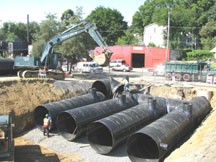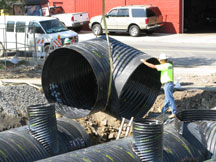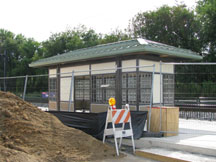 Polymer Coated CSP Primes SEPTA Station for 100-Year Service
Polymer Coated CSP Primes SEPTA Station for 100-Year Service
Polymer coated CSP storm water management system provides 100-year service life, meets restricted site discharge of SEPTA’s Olney Station
By Mike McGough, P.E., Chief Engineer, NCSPA and Jerome S. Silagyi, P.E., Manager of Technical Services, Lane Enterprises
Located in the Olney neighborhood of Philadelphia, the SEPTA R8 Fox Chase Line facility now has somewhat of a resurrection story in its 100-year history. Originally constructed by the Reading Company in 1906, the Olney Station was decommissioned when the Southeastern Pennsylvania Transportation Authority (SEPTA) ceased allowing customers to use the station in the 1980’s. Several decades later in June of 2008, the station was demolished to make way for a new facility with high level platforms. What the site was soon to realize in its resurrection is that building requirements have changed dramatically over the past century, most notably that pertaining to storm water management.
What would once have been an impossible task to accomplish for a small site that hosts some sixty parking spaces has become possible with the advent of underground storage systems. Over the past couple decades, the traditional detention pond has given place to buried storm water management systems (SWMS) that preserve operational functionality of the much-needed space in the heart of urban development, or in this case, urban re-development. In this vein, corrugated steel pipe (CSP) has found new life and become the leading option available for engineering designers availing themselves of the strength, service life, constructability and size range afforded by this engineering material.
SEPTA’s multi-disciplined engineering department was able to provide cradle-to-grave site development, beginning with conceptual design and ending with construction management. The reviewing agency responsible for storm water management was the Philadelphia Water Department, who quickly assigned a restricted storm water discharge to mitigate an outlet that had become overtaxed through the years. The restricted storm water discharge assignment necessitated a detention requirement in excess of 15,000 cubic feet.
100-Year Pipe for a 100-Year Facility
 With limited area to accommodate this amount of storage, SEPTA engineers decided on a 7-ft diameter CSP SWMS with an overall dimensional footprint of 94 ft x 37 ft. Of particular interest is the type of CSP specified by the SEPTA design engineers – Polymer Coated CSP.
With limited area to accommodate this amount of storage, SEPTA engineers decided on a 7-ft diameter CSP SWMS with an overall dimensional footprint of 94 ft x 37 ft. Of particular interest is the type of CSP specified by the SEPTA design engineers – Polymer Coated CSP.
Polymer coated CSP was selected for its design service life of 100 years, which is coincidently the historical design life of the facility. Of the three major coating types available in the CSP market today (galvanized, aluminized and polymerized), polymer coated CSP provides the greatest service life and is the premier coating available today for CSP.
The polymer coating consists of a 10 mil polymer film that is laminated over each side of a galvanized steel coil prior to the pipe manufacturing process. The TRENCHCOAT™ Protective Film is a tough, rugged polyolefin laminate that provides galvanized CSP with a durable barrier that exceeds the corrosion and abrasion resistance of all other coatings, with the added feature of providing a service life of 100 years.
Another feature of utilizing CSP for underground storage purposes is the ability of the pipe manufacturer to fabricate fittings, manifolds, access risers, flow control structures, as well as any other appurtenances needed to support the hydraulic functions or maintenance of the system. Fabrication is accomplished with experienced welders using the very material specified for the SWMS, in this case a 7-ft diameter polymer coated CSP.
 To provide the most efficient use of the available storage and minimize potential clogging and related maintenance demands, a 3-in conical Reg-U-Flo® Vortex Valve (RVV) was used to meet the discharge limit requirements. The RVV is a rugged self-regulating flow control device made with 304 stainless steel. As part of the detention system’s outlet, the valve was easily fastened to a 7-ft diameter bulkhead.
To provide the most efficient use of the available storage and minimize potential clogging and related maintenance demands, a 3-in conical Reg-U-Flo® Vortex Valve (RVV) was used to meet the discharge limit requirements. The RVV is a rugged self-regulating flow control device made with 304 stainless steel. As part of the detention system’s outlet, the valve was easily fastened to a 7-ft diameter bulkhead.
Unlike an orifice, vortex control increases as the pressure builds, having little control initially and maximum control once the design head is reached. This unique feature allows the RVV to be oversized without exceeding the discharge limit when the system is full. In this case, a 3-in orifice would have exceeded the allowable rate at a system depth of 10 inches, while the 3-in RVV does not exceed the allowable rate for the full range of storage depth available in the system.
The SWMS was easily assembled as pieces were delivered from the manufacturer, Lane Enterprises, from their nearby King of Prussia, Pa., facility, located less than 20 miles from the project site. A just-in-time delivery procedure helped manage a very space-limited site and allowed the contractor, D’Angelo Bros., to better manage ingress and egress from one end of the site to the other.
Aside from providing customer parking, SEPTA’s construction management team was able to maintain functionality of the Olney Station for its users as evidence of the station’s need presented itself with the numerous neighborhood residents walking to and from the site throughout each day during the construction process. A resurrected facility teeming with new life to mark a century of use.
™Trademark of The Dow Chemical Company
Mike McGough, P.E., is chief engineer for the National Corrugated Steel Pipe Assn. McGough can be reached by e-mail here. Jerry Silagyi, P.E., is manager of technical services for Lane Enterprises, Inc. Silagyi can be reached by e-mail here.</>
